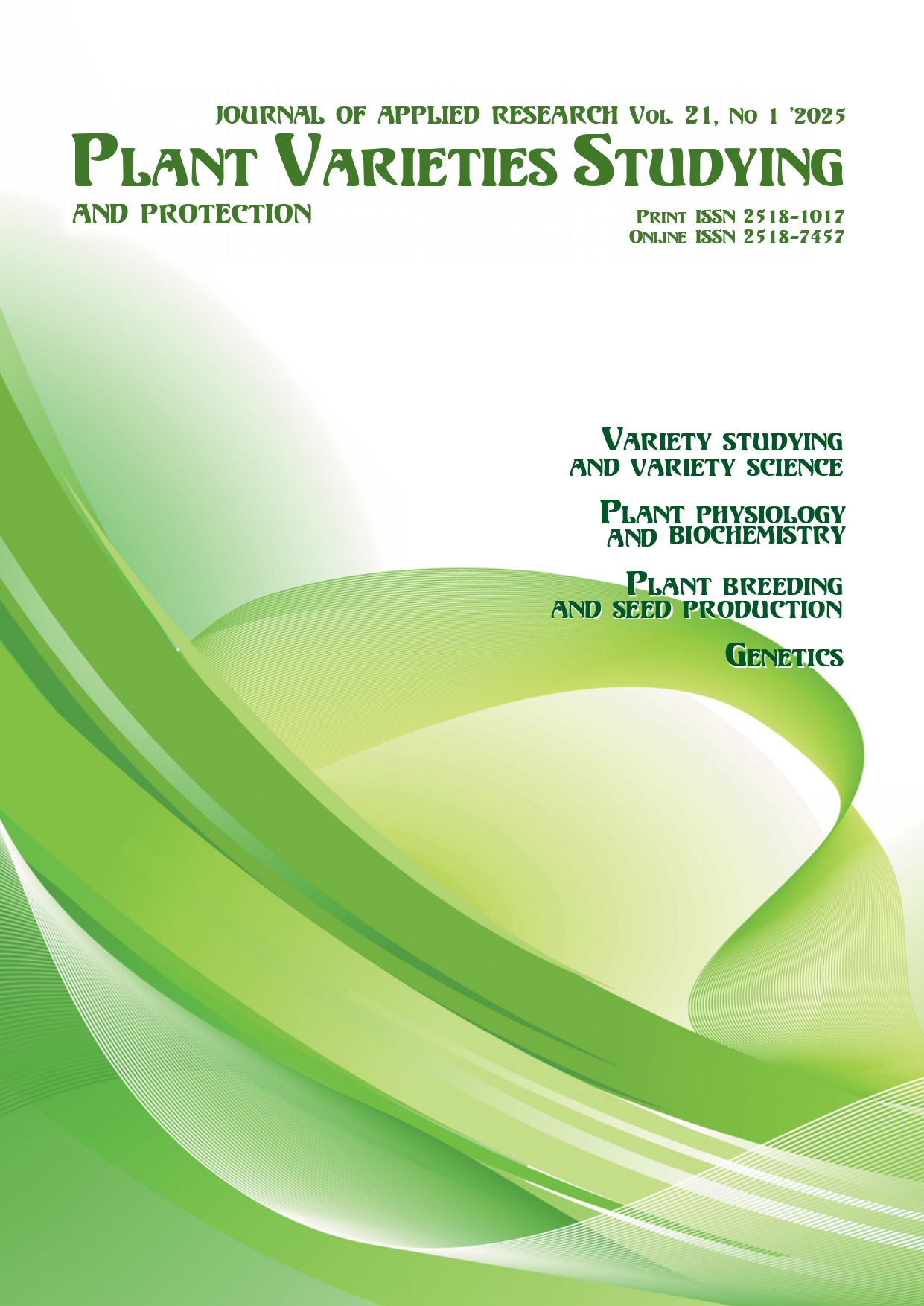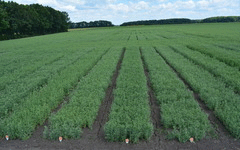The content of polysaccharides in plants of the genus Dahlia Cav. introduced in the M. M. Gryshko National Botanical Garden
DOI:
https://doi.org/10.21498/2518-1017.21.1.2025.327496Keywords:
plants of the genus Dahlia, root tubers, leaves, polysaccharide complexAbstract
Purpose. To investigate the polysaccharide content of different plant organs from varieties and hybrids of the Dahlia genus introduced to the M. M. Gryshko National Botanical Garden during the growing season. Methods. The quantitative content of polysaccharides was determined by the weight method, while glucose, fructose and sucrose were determined by the chromatographic method. Results. The maximum polysaccharide content in root tubers at the end of the growing season was recorded in ‘Osin v Sofiivtsi’ (101.00 ± 0.1%); the others had values ranging from 67.90 ± 0.1% in ‘Canby Centennial’ to 90.0 ± 0.2% in ‘Kiki Karon’. During storage, these values decreased by almost half for ‘Osin v Sofiivtsi’, ‘Kiki Caron’ and Hybrid No. 150, while remaining at a similar level for ‘Canby Centennial’. The main soluble sugars in the Dahlia cultivars’ roots are glucose, fructose and sucrose. Their total content at the end of the growing season in autumn ranged from 8.0% (‘Canby Centennial’) to 11.5% (Hybrid No. 150). Storing the root tubers for four months in a cool room at a temperature of 5–8 °C and humidity of 50–60% had a positive effect on the soluble sugar content, which increased by 1.3–1.8 times [from 14.72% (‘Canby Centennial’) to 21.86% (Hybrid No. 150)]. The total amount of polysaccharides in the leaves of Hybrid No. 150 did not exceed 6 ± 0.02%, and was even lower in the other varieties: ‘Kiki Canon’ – 2.9 ± 0.01%, ‘Osin v Sofiivtsi’ – 1.8 ± 0.01%, ‘Canby Centennial’ – 1.6 ± 0.01%. Conclusions. Based on the results of the study, it can be concluded that the roots of Dahlia plants, which can retain polysaccharides even in winter, are a potential non-traditional source of these biologically active compounds.
Downloads
References
Marchyshyn, S. M., Demydiak, O. L., Dakhym, I. S., Berdei, T. S., & Kozyr, H. R. (2015). Research of polysaccharide complexes from Asteraceae family plants. ScienceRise, 10(4), 31–36. https://doi.org/10.15587/2313-8416.2015.52002 [In Ukrainian]
Thakur, P., Shah, A. H., Adhikari, Y., Kumar, M., & Verma, S. (2022). Dahlia cultivation in India andabroad: A Review. International Journal of Plant & Soil Science, 34(19), 240–251. https://doi.org/10.9734/ijpss/2022/v34i1931108
Doroshenko, A. S., Dzhurenko, N. I., Palamarchuk, O. P., & Koval, I. V. (2012). Studies of representаtives of the genus Dahlia Cav. in National Botanical Garden named after M. M. Gryshko of National Academy of Sciences Ukraine. News Biosphere Reserve “Askania Nova”, 14, 504–507. [In Ukrainian]
Muzychuk, H. M., & Doroshenko, A. S. (2004). Preliminary evaluation of varietal diversity of the Dahlia Cav. collection fund of the M. M. Hryshko National Botanical Garden of the NAS of Ukraine. Visnyk of the Lviv University. Series Biology, 36, 24–30. [In Ukrainian]
Onozaki, T., & Azuma, M. (2019). Breeding for Long Vase Life in Dahlia (Dahlia variabilis) Cut Flowers. The Horticulture Journal, 88(4), 521–534. https://doi.org/10.2503/hortj.utd-091

Horobets, V. F., Mashkovska, S. P., Tymchenko, O. D., Buidin, Yu. V., & Shcherbakova, T. O. (2005). Department of Floriculture and Ornamental Plants: Past and Present. Plant Introduction, 3, 43–51. [In Ukrainian]
Berlin E. A., & Berlin, B. (2015). Medical ethnobiology of the highland Maya of Chiapas, Mexico: the gastrointestinal diseases. Princeton University Press.

Rahman, A. H. M. (2013). An Ethno-botanical investigation on Asteraceae family at Rajshahi, Bangladesh. Academia Journal of Medicinal Plants, 1(5), 92– 100.
Gontova, T. M., Kichymasova, Ya. S., & Ilyinska, N. I. (2014). Studying of the vitaminous and elemental composition of the herb and tubers of Dahlia Ken's Flame genus. Collection of Scientific Works of Staff Member of P. L. Shupyk NMAPE, 23(4), 245–249. [In Ukrainian]
Gontova, T. M., & Ilyinska, N. I. (2013). A study of the components composition of essential oil in tubers Dahlia nymphaeaceae. Ukrainian Biopharmaceutical Journal, 3, 49–51. [In Ukrainian]
Gontova, T., Ilyinska, N., Golembiovska, O., & Mashtaler V. (2016). Study of the component composition of phenolic compounds obtained from Dahlia varieties Ken’s Flame herb. Der Pharma Chemica, 8(18), 455-459.

Beridze, O., & Kovalchuk, I. (2019). Evaluation of Collection Stock of Plants of the Genus Dahlia Cav. in the Kremenets Botanical Garden. Notes in Current Biology, 3, 5964. https://doi.org/10.29038/2617-4723-2019-387-59-64
Espejel, E. A. R., Alvarez, O. C., Muñoz, J. M. M., Mateos, M. D. R. G., León, M. T. B. C., & Damián, M. T. M. (2019). Physicochemical quality, antioxidant capacity and nutritional value of edible flowers of some wild dahlia species. Folia Horticulturae, 31(2), 331–342. http://dx.doi.org/10.2478/fhort-2019-0026

Maloshtan, L., Shakina, L. Gontova, T. Romanova, S., & Yaremenko, M. (2021). The study of the cytotoxic activity of the dry extract and the anthocyanin complex of Gebu Dahlia variety flowers. Ukrainian Biopharmaceutical Journal, 1, 16–21. https://doi.org/10.24959/ubphj.21.295 [In Ukrainian]
Kelly, G. (2009). Inulin-type prebiotics-a review: part II. Alternative Medicine Review, 14(1), 36–55.
 |
| 
Shoaib, M., Shehzad, A., Omar, M., Rakha, A., Raza, H., Sharif, H. R., Shakeel, A., Ansari, A., & Niazi, S. (2016). Inulin: Properties, health benefits and food applications. Carbohydrate Polymers, 147, 444–454. https://doi.org/10.1016/j.carbpol.2016.04.020
 |
| 
State Pharmacopoeia of Ukraine (2nd ed., Supplement 1). (2016). State Enterprise “Ukrainian Scientific Pharmacopoeial Center for Quality of Medicines”. [In Ukrainian]
Pochynok, Kh. N. (1976). Determination of glucose, fructose and sucrose in plants from a single sample. Naukova dumka. [In Ukrainian]
Downloads
Published
How to Cite
Issue
Section
License
Copyright (c) 2025 N. I. Dzhurenko, O. P. Palamarchuk, O. V. Sokol, Yu. V. Buidin, S. P. Mashkovska, A. S. Doroshenko

This work is licensed under a Creative Commons Attribution-ShareAlike 4.0 International License.
Starting in 2022, the copyright to the publication remains with the authors
Our journal abides by the CREATIVE COMMONS copyright rights and permissions for open access journals.
Authors, who are published in this journal, agree to the following conditions:
- The authors reserve the right to authorship of the work and pass the first publication right of this work to the journal under the terms of a Creative Commons Attribution License, which allows others to freely distribute the published research with the obligatory reference to the authors of the original work and the first publication of the work in this journal.
- The authors have the right to conclude separate supplement agreements that relate to non-exclusive work distribution in the form in which it has been published by the journal (for example, to upload the work to the online storage of the journal or publish it as part of a monograph), provided that the reference to the first publication of the work in this journal is included.

























 Ukrainian Institute for Plant Varieties Examination
Ukrainian Institute for Plant Varieties Examination  Селекційно-генетичний інститут
Селекційно-генетичний інститут Institute of Plant Physiology and Genetics of the National Academy of Sciences of Ukraine
Institute of Plant Physiology and Genetics of the National Academy of Sciences of Ukraine
 The National Academy of Agrarian Sciences of Ukraine
The National Academy of Agrarian Sciences of Ukraine